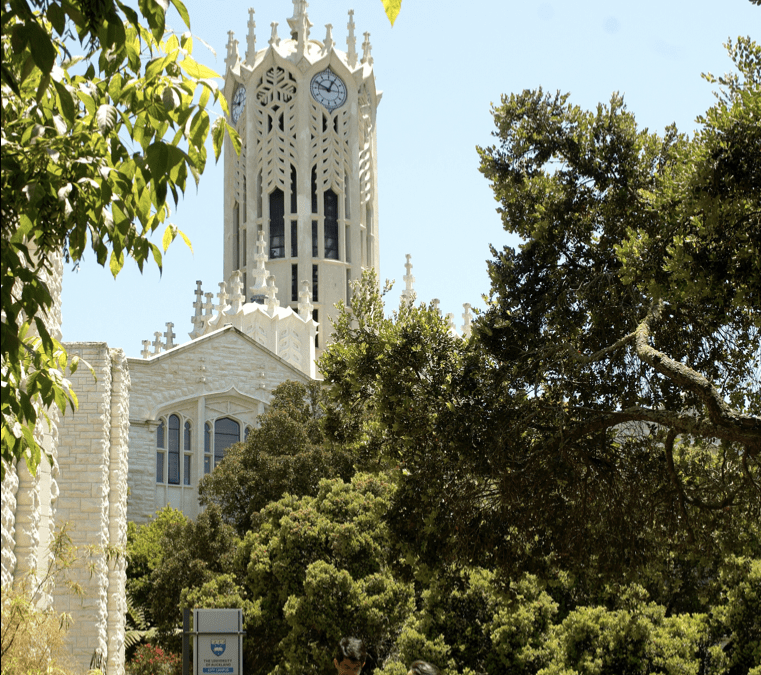Today the Clock Tower is central to the university campus’ identity. Amid more modern buildings, like OGGB’s sleek glass atrium, or the engineering building’s functional, futuristic model, the Clock Tower stands out for its Gothic spires rising out of a mass of native bush. From afar, it ties the university into the broader landscape of Albert Park, the High Court’s Gothic Revival architecture, and the mass of greenery around Eden Crescent Street. The Clock Tower is also a distinctively New Zealand building.
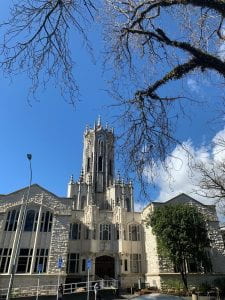
The Clock Tower, seen from Princes Street.
Interestingly, it was one of the most controversial buildings when it was first constructed. Newspaper clippings show public outrage when it was first built – people said it would scare old ladies in the park (Fairburn), and others referred to it as a wedding cake. It was treated like a scandal, something appalling, distinct from the colonial houses on Princes Street, which resemble houses that could be seen in London. Some theorise that this is because it was a jarring reminder that New Zealand had its own identity, and was not merely an extension of England. At the time, people imagined New Zealand to be a little England, and architects largely followed English models. For instance, the Auckland Cenotaph, built in 1920, was modelled exactly after the Cenotaph in London – (interesting side note, the English government only offered to sell the blueprints for the cenotaph at an exorbitant price, so New Zealand architects sketched the plans for the cenotaph based on cinema newsreels).
Why and how did the Clock Tower break away from this pattern? American architect Roy Lippincott was commissioned to design a building for the humanities. He was part of a burgeoning movement called modernism across architecture, literature, and music – modernist buildings are designed for people, rather than serving as symbols of wealth or power. Essentially, all form in a modernist building should have a function, rather than just being ornament. The goal is to center the individual rather than make them feel intimidated by too much decoration.
Roy Lippincott was ahead of his time. He took a risk, honing into what was unique about New Zealand’s character, distinct from the shadow of the Empire. He fused Gothic influences and borrowed from the vernacular to make one of the first uniquely New Zealand buildings, when New Zealanders were still subjects.
Inside, the Clock Tower is a serene and uplifting space, through geometry, clean lines, large windows, stained glass, and facing north for maximum light. Abstractions of local flora and fauna decorate its pillars, facades, balustrades, and windows, including flax-seed pods, ponga fronds, the kākā and kea. This was one of the first times that local flora and fauna were incorporated in architecture – a return to nature was part of national identity. The greenery surrounding the Clock Tower was specially chosen so that it would grow around the spires – Lippincott took a long view of time. In some ways, the Clock Tower has reached Lippincott’s original vision, now that the trees have grown to full height.
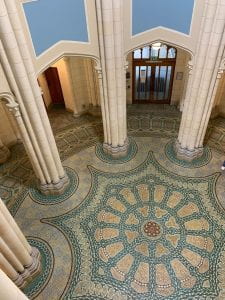
Inside the Clock Tower.
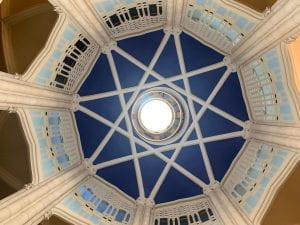
Modernism uses symmetry and minimalist design to obtain an aesthetic effect. “Either use no ornament, or good ornament.” – T.S. Eliot.
I love the history of the Clock Tower because it shows how what we find beautiful changes, but also that a reaction on art shows the values of a society at a given time. People found it hard to see beauty in something they’d only seen for the first time. There is something comforting in knowing that the things that make us uncomfortable may have deeper lessons in them. The writer and critic Susan Sontag and playwright Bertol Brecht both believed the point of art is to discomfit, to make the viewer uncomfortable – that is the only way to challenge us and make us understand the world we interact with, and our place in it.
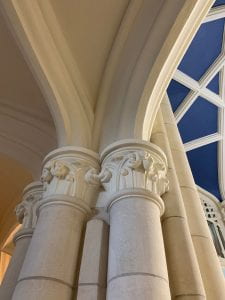
Examples of native flora on pillars.
McLean, “Auckland University Old Arts Building.”
https://gettinglost.co.nz/getting-lost-bit-history/
Photo credit: myself and International Scholastic Group, retrieved at https://www.chooseright.org/university-of-auckland/
https://gettinglost.co.nz/getting-lost-bit-history/
Sontag, Susan. Against interpretation, and other essays. New York: 1966, Farrar, Straus & Giroux
